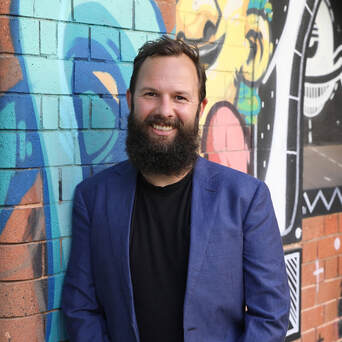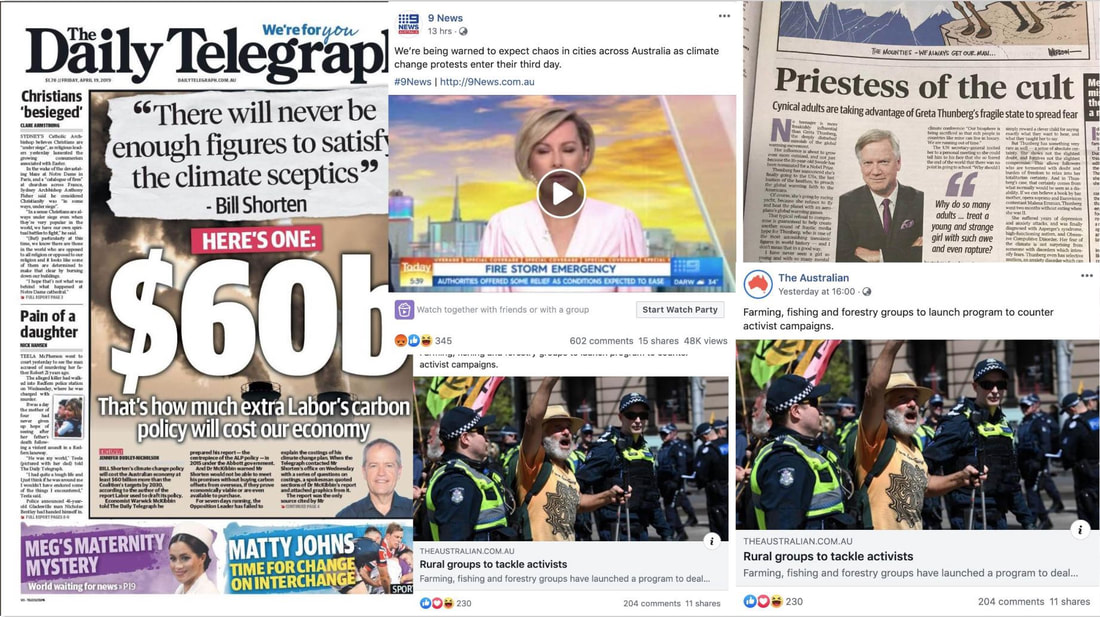Callan LawrenceCallan Communications

Callan is a former journalist for The Sydney Morning Herald, Sun-Herald, and Fairfax Community Newspapers. More recently he has worked in corporate communications and marketing for NGOs delivering refugee and migrant services, as well as other non-profit organizations and businesses. He has a bachelors in communications and Masters in digital communications and cultures from Sydney University.
PresentationClimate change replaced refugees as the media wedge issuePresented on 11th October 2019 at the inaugural Hunter Climate Summit (2019)
For four years I worked in a small communications team for Australia’s largest refugee and asylum seeker services provider. We were effectively the PR team for refugees and people seeking asylum because journalists came to us for comment on a weekly and often daily basis. We also wanted to play an advocacy role.
This was 2013 to mid-2017, Tony Abbott was in power for half of that time, with Scott Morrison and Peter Dutton the immigration ministers. People who had come to Australia for refugee protection, in one way or another, were the BIG news story most weeks. Refugees and asylum seekers were used as a ‘wedge issue’. The Abbott Government and its media allies marginalised those people and framed them as the biggest threat to Australia’s security and prosperity. They were blamed for everything: from congestion on the roads, to being ‘illiterate and innumerate’ welfare bludgers who would, conflictingly, take our jobs; and, most poignantly, to being potential Islamist terrorists. They were, and still are, framed that way because politicians and their media allies know that some people believe them, and the more people they can convince, the more people they can sell a solution to and convince to vote for their party. That strategy of convincing more and more people is based on fear, pitting people against each other and manipulating us to taking sides.
I hope you’re starting to see some parallels to the current BIG news story of climate change and climate activists. In that atmosphere of fear and loathing of predominantly Islamic foreigners, our team decided to promote stories about their soccer prowess. At the time, recently arrived refugees with poor English, no money and trauma, had no structured route to join a soccer club if they wanted. And we’re talking about thousands of people who are soccer fanatics. Sport is a great leveller. Especially in Australia. If you’re interested in the same sport as someone, it’s a great icebreaker. And for those among us who lack a little on the empathy side, it demonstrates common interests and values. We wrote stories about young people from Afghanistan, Pakistan, Sierra Leone, Iraq, Iran and other nations, who gathered in parks around Sydney to play soccer EVERY DAY. If they were seeking asylum, they lived on 80% of the already pitifully meagre Newstart allowance; they could not work or get an education because our government would not give them those rights. So they played soccer. But not for a club in an organised competition. They played on the few fields that were not otherwise used in Sydney, in teams and comps organised by themselves. Our goals in writing and talking about this story were to:
We were finding commonality to frame our messages about refugees from Islamic cultures, to hopefully get through to people. These stories were published by The Sydney Morning Herald, The Daily Telegraph, Adelaide Advertiser, on ABC Sydney radio, and other publications. People contacted us with offers of money and in-kind support. It directly helped us create a pathway for refugees and people seeking asylum to join legitimate soccer clubs and competitions in Sydney. We also used art, music and ethnic cuisine to frame common interest stories about those people from foreign lands. In all, that work went a long way towards helping those individuals break out of their silos, meet Australian people, and in some cases find education and employment pathways. Although a record numbers of people came to Australia to seek refugee protection in the years since, it hasn’t been the big story it was. I’d love to say it was because our strategy worked, but it has far more to do with a bigger story taking all the attention. Climate change and climate activists are the new wedge issuePoliticians and the mainstream media have turned their wrath on climate change activists: those of us who take to the streets to demand actions that will turn the world away from climate change disaster.
Dutton signalled for vigilante justice when he said activists should be ‘named and shamed’, as homosexuals and protesters who once demanded gay rights were. He also wants mandatory jail sentences for protesters. In an odd show of bipartisanship, the Queensland Palaszczuk Government is looking to rush through new laws to impose jail time. Media big mouths, including Kerri-Anne Kennerley, have called for protesters to be run over or jailed and not fed because they delay traffic. Don’t be surprised if we’re soon called terrorists. In the right wing media — The Daily Telegraph, The Australian, Herald Sun, Sky News, The Today Show and Sunrise, 2GB — this covers the majority of the news consuming public in Australia. By the sheer amount of noise these publishers make, they frame the way most Australians get their information. Here are some recent headlines:
The first one is from the election campaign. But these others are very recently about Extinction Rebellion protests and the UN Climate Change Summit in September.
Those headings and intros are NOT talking about why activists are protesting. They are talking about the disruption they are causing rather than WHY they are being disruptive. The XR strategy is that any publicity is good publicity for them: the condemnation and criminalisation will hopefully create a sense of martyrdom that encourages more people to join; and conversely, if the movement is accepted by the media and leaders, more people will also join. And both paths should lead to action. In the Australian context, however, at least in the short and medium term, our so-called leaders and the right-wing media are successfully framing these XR protests. And of course, they won the framing of Labor’s election policies. The protests may have a positive effect in creating a movement and recruiting more activists, and they may in the long-term pressure leaders to do something substantial. I hope they do. But for now, the people who voted for the LNP government and its lack of climate or environmental policies see these headlines and footage of protesters interrupting their morning commute. I’m not sure that media coverage will change many of the minds that need changing. I also don’t think any media publicity is good publicity. These headlines and images of protesters stopping traffic in bee suits may actually further divide climate change deniers from the rest of us. That could provoke them to more aggressively oppose action. I predict more conflict before cohesion. I guess that’s how protest movements like this work, though. On the other side of the media spectrum, you could say is The Guardian and Crikey. And somewhere in the middle the ABC and Sydney Morning Herald. Here some comparison headlines from this month:
So, why is the news so partisan. We have major news organisations campaigning by proxy against reality of climate change, others report what they believe to be the facts and others more aggressively campaign for change to prevent or limit climate change.
Aren’t journalists supposed to report the facts? Yes, that’s the job description. The Media Entertainment and Arts Alliance has a code of ethics and the principles on which it is based are:
Unlike the medical, education or legal professions, however, journalists can’t be banned from being journalists for misconduct such as misrepresentation of facts. More to the point, facts are either believed or not depending on someone’s lived experience. We need a trusted source or emotive, verifying experience to help us believe facts. This has always been the case. Media 101 says wrap facts in believable, stories that connect on emotion. There are psychological reasons for that. Facts are boring and may not have any immediate relevance. On the other hand, emotions are powerful and immediate and command us to act. If you read that science has shown bushfires will become more frequent due to climate change, you still buy a house in the bush because you see no immediate need to avoid that. If you’re friend’s house burns down in a bushfire, you have an emotional response and you may then be fearful of buying that house in the bush. There is also a distinction between reporters and commentators. Reporters need to be based somewhat in fact to report on events, but they can choose how to present them and what to omit. Commentators are free to rant about whatever subject gets under their skin, or whichever their bosses advise them to. As Alan Jones and Andrew Bolt demonstrate. And it’s the commentators of News Ltd, Sky News, 2GB, the Nine network, that are stridently berating activists and scientists about their views on climate change. Or sowing seeds of doubt. It comes back to the wedge issue. Like politicians, media executives now cultivate an audience to drive revenue. By dividing people into categories of interests and values — such as people concerned about jobs, or people who dislike greenies — media organisations design their stories to appeal to a demographic. There was a time when factual middle ground reporting was the most economical model. Before the digital era allowed us to track every click and action online, media ads were sold based on the bulk of the potential audience. To maximise ad revenue, media had to appeal to the largest audience possible and so stories were balanced to appeal to the centre of the political spectrum. The digital media revolution gutted that advertising revenue and diversified the number and spectrum of media channels. Ads are now sold by volume of link clicks and engagement on a news site — comments, likes, etc. Subscription models also now make up a large portion of news revenues. The most profitable way of running a publication is now to cultivate the most engaged — or fanatical — audience and that is done be appealing to people’s existing values and bias. So how should climate change campaigners work with media?So this question depends on your strategy and goals.
If your goal is to get publicity and build a movement of like-minded people, for a protest or petition for instance, climate change activist can do well using the Guardian, ABC and Crikey and other supportive media. If your goals are to get political or business leaders to take actions, you need to convince their constituents and customers. And currently, those constituents are not the readers of the Guardian and Crikey. While it’s more palatable to only engage with the media channels and publications that reflect our own values and ideas, that doesn’t help us break new ground as campaigners. To change minds or build large scale public support, media campaigns need to frame their stories and strategies in common values, experiences and interests and talk to people who you may not think are on your side. |
Summit Speakers
|




